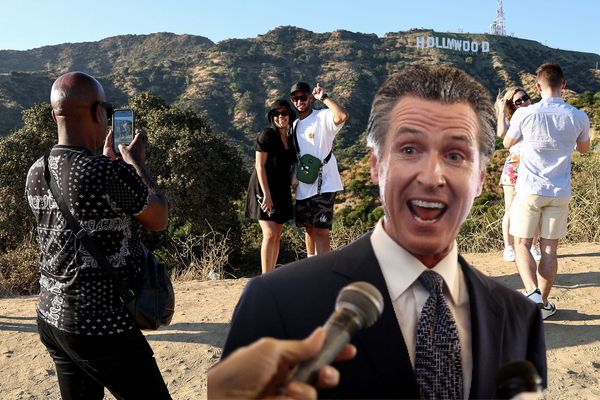
There are neither images nor narrative in Steve McQueen’s newest work, Bass, at the Dia Art Foundation at Beacon, about an hour up the Hudson valley from New York. Nothing but three stacks of speakers standing in the low-lit gloom of a concrete basement, and a grid of 60 flat LED light boxes sitting flush with the ceiling, measuring out the space between the rows of pillars and providing the only illumination in the large, echoing space. The light boxes glow red then tangerine, through yellows and green, blues and magenta and back to red, slowly drifting round the spectrum like a dial being turned.
Along with the light, sounds hang in the air. Sometimes the reverb goes right through you, then it’s a ghost. Slick with dulled reflections, the concrete floor is scored with old cracks and worn-away markings. The throb of bass notes ricochet from the walls and pillars, an underground shooting gallery of dub. Aching and surging, tailing off and picking up again, the music creates a space in which riffs and licks come and go are lost in reverb and harmonics, like snatches of language being dragged out of nowhere. Notes pulse like a human heart or a rudder in a current. Enormous tonal weights slide like so much unmoored ballast, blues phrases shimmer in complaint and there’s a constant sense of the impending. At one point a low hollow sound tunnels through the air like disaster looming.
A few months ago McQueen got legendary bass player Marcus Miller (who has worked with everyone from Miles Davis to Luther Vandross) to assemble a group to play here over two days. Miller played electric bass alongside Jamaican musician Aston Barrett Jr, (son of Aston “Family Man” Barrett, bass player in Bob Marley’s band, the Wailers); Malian musician Mamadou Kouyaté (also the scion of a musical dynasty), playing the bass ngoni (an ancient instrument, the West African ngoni later evolved into the banjo); 18-year-old upright bass player Laura-Simone Martin from New Jersey, and bassist, rapper and songwriter Meshell Ndegeocello, an 11-times Grammy nominee (she has won two). All the musicians, as well as the artist himself, are part of the African diaspora. Most had never met, much less played together before. They performed in the same echoing basement Bass now occupies, improvising under McQueen’s direction for two days. Edits to the recorded performance, which lasts for over three hours, were minimal. McQueen is credited as conducting the performance, though whatever directions he gave, I can’t quite see him wielding a baton.
Bass is a threnody, the music originating in the West African musical idioms that were carried across the Atlantic along with the enslaved, and which later developed in the Americas and in the Caribbean. The atmosphere shifts from one moment to the next, following a rhythm then losing it again as the light shifts and the colour changes. The people passing through the space drift and wander, prop themselves against the pillars and sit on the floor. The atmosphere slows you down, and you find yourself watching others as they move around, pensive or adrift, casting no shadows in the coloured gloom. We are on the verge of disappearance, catching ourselves listening and caught looking, lost in our own thoughts. Attentiveness comes and goes. Suddenly the room seems bathed in yellow. The last time I looked everything was blue, and the bass line has shifted into a different rhythm. The turn of the light evokes a succession of unending days and we are suspended in the middle of things, between origin and arrival. The music has no beginning or end. There is no release.
Although you can think of McQueen’s Bass as a light and sound installation, belonging to the same tradition of art-making as all those Richard Serras, the Dan Flavin neons, the Gerhard Richters and Robert Ryman’s endlessly white paintings that fill Dia Beacon, down here in the basement we are somewhere else.
Founded exactly 50 years ago, Dia occupies several buildings in Manhattan, as well as acting as steward to epic land art works including Robert Smithson’s Spiral Jetty in Great Salt Lake and Nancy Holt’s Sun Tunnels in Utah. Dia took over and converted the former Nabisco box factory at Beacon at the turn of the millennium, and McQueen’s newest work, which opened on Sunday, will stay here until next year, when it will move to the Laurenz Foundation’s Schaulager in Basel, Switzerland. You can think of McQueen’s Bass in relation to La Monte Young’s attenuated drones and Pauline Oliveros’s “deep listening”, to minimalism and installation art, but it leads much further back. Bass is also utterly consistent with other works by McQueen. It slows you down and sucks the air out of you. Bass is vertiginous, compelling and very moving. The rumbling echoes leak beyond the building at Beacon, where a river makes its way to the Atlantic and a railroad is heading into the interior. The bass is under everything and it is everywhere. You can feel it going through you.
McQueen is one of the best artists we have, whatever medium he choses. He never gives you what you expect, and whatever you think you know about him, he always takes you somewhere else.







